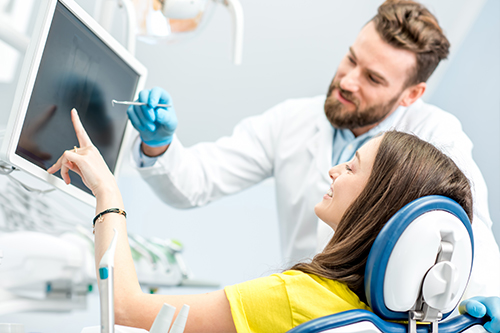


A generation ago it was extremely unusual to see an adult with braces on their teeth. Today that is no longer the case. Thanks to advances in dental technology, greater access to care, and an increased awareness of the benefits of a beautiful and healthy smile; now over twenty percent of people wearing orthodontic appliances are adults.
With the wide variety of orthodontic treatment options available to adults, the process of wearing braces is more convenient, more comfortable, more efficient and much less conspicuous than ever before. Bulky metal braces are truly a thing of the past. The latest generations of metal appliances are substantially smaller and less unsightly than any of their predecessors. Moreover, an adult interested in orthodontic care can select braces that are hardly visible at all. Today’s tooth -colored ceramic braces, lingual braces or removable clear aligners can all effectively deliver treatment to achieve successful and pleasing outcomes of care.
Although, adult orthodontics requires an investment of time and resources the payoff is well worth it. The value of a healthy and attractive smile is priceless. Thanks to modern orthodontics, having teeth that look good and function well is something that can be enjoyed at any age.
In cases where a set of conventional braces is the best approach to care, but a more cosmetic appearance is desired, ceramic braces offer an excellent alternative to metal braces. Ceramic braces, or clear braces, blend in with the natural color of your teeth. While being far less visible, they still function in very much the same way as metal braces to deliver outstanding results of care. An excellent aesthetic choice, ceramic braces can be a bit more fragile than their metal counterparts.
Damon® braces are specially designed self-ligating appliances that offer several advantages over traditional orthodontic brackets. Using a sliding mechanism instead of individual elastic ties to secure each brace to the orthodontic wire, the Damon system of braces makes tooth movement more efficient as well as more comfortable. With Damon braces not only are fewer adjustments and less frequent visits required, treatment is typically completed in a shorter period of time. Moreover, without the presence of elastic ties, less food and bacteria can accumulate around the braces, thereby making it easier to keep the teeth clean.
Combining a self-ligating bracket design with the use of high technology archwires, the Damon system reduces friction to put less pressure on the teeth. As a general rule, with Damon braces less discomfort is experienced and the potential for dental disease, stains, decalcifications and other types of damage to the teeth or supporting structures is reduced.
Depending on lifestyle and needs, Damon braces are available in both metal and clear options.
Digital radiography utilizes computer technology and digital sensors for the acquisition, viewing, storage, and sharing of radiographic images. It offers several advantages over the older traditional film based methods of taking x-rays. The most significant of theses advantages is that digital radiography reduces a patient’s exposure to radiation. Other benefits are that images can be viewed instantly after being taken, can be seen simultaneously as needed by multiple practitioners, and can be easily shared with other offices. Digital x-rays are also safer for the environment as they do not require any chemicals or paper to develop.
An electronic pad, known as a sensor is used instead of film to acquire a digital image. After the image is taken, it goes directly into the patient’s file on the computer. Once it is stored on the computer, it can be easily viewed on a screen, shared, or printed out.
An innovative, discreet, and effective system of care, Invisalign® treatment offers a cosmetic way to align your smile with minimal interference to daily activities using a series of clear aligners.
With aligners that are practically invisible, only you will know that you're undergoing orthodontic care! Invisalign may, in most cases, eliminate the need for unsightly, uncomfortable, unattractive bands and wires. Whether you are a teenager who needs braces to correct a malocclusion or an adult who would like to straighten out some crooked teeth, Invisalign may well be the answer for you!
Invisalign utilizes 3-D computer imaging technology to correct problematic bites or malocclusions by planning a complete sequence of custom-made clear aligners. This series of clear aligners incrementally move the teeth into place until the final desired corrections are reached.
As pioneers in the field of aligner development and technology, the folks at Align Technology, Inc. gather data from millions of treated smiles to design treatment systems that:
Custom-made to the exact specifications of your smile, Invisalign clear aligners are designed to incrementally move your teeth into their correct positions over time. Simply swap-out last week's aligner for the next one in the series and watch as your smile progressively shows signs of improvement.
And, because Invisalign clear aligners are removable for short periods of time, as opposed to traditional braces, you can still enjoy the foods you love as well as brush and floss your teeth with ease!
Whether you are a teen who needs braces or an adult who yearns to "fix" their smile, Invisalign clear aligners may be the perfect solution for you! Contact our office for more information and to schedule a consultation for care.
Your doctor will examine your teeth and show you what Invisalign treatment can do for you.
Start with a fast, precise digital scan. Then your doctor will map out a custom treatment plan just for you. You will even get a preview of your smile.
Your clear aligners are created using industry leading technology based on your customized treatment. Your aligners are created with comfort in mind.
From the first day of treatment to the last, you're never on your own — your doctor will be with you every step of your way.
*Invisalign is a registered trademark of Align Technology, Inc.
There are many options for patients who want to avoid metal braces! The most popular alternative orthodontic treatment is Invisalign®, which are clear plastic aligners designed to straighten teeth. After an examination of your teeth, your dentist will determine which option is best suited to your wants and needs.
According to the Invisalign® website, the cost for treatment is approximately the same as the cost for metal braces. A portion of this cost may be covered by your insurance. Please call Orthodontics, Inc to set up a consultation and discuss potential payment plan options.
The first step is to schedule a consultation with your doctor, so they can devise a treatment plan that is best suited to your individual dental needs. Once approved, you will receive your first set of aligners. Your doctor will then regularly monitor the movement of your teeth and new aligners will be ordered according to the progress made in your treatment plan.
Invisalign® aligners are made of clear, flexible plastic. The company received a patent for this material – SmartTrack® – to be used exclusively for Invisalign treatment purposes. These aligners are FDA approved and nearly invisible!
Your doctor will give you an estimate regarding how long your Invisalign® treatment should take, which will depend on your specific needs. The average length of time for treatment is approximately 12-18 months. However, some patients may see results far sooner. Remember to wear your aligners exactly as instructed by your doctor to obtain the best results.
Your doctor will most likely recommend that you wear retainers following your Invisalign® treatment. This is a precaution that will prevent your teeth from shifting back to their original positioning. It is important to follow your doctor's instructions exactly to ensure long-lasting results.
You must wear your aligners for up to 22 hours daily. You may remove them for eating, drinking and regular oral hygiene.
No. Unlike braces, you may eat whatever you like as long as you remove the aligners before eating. Prior to placing the aligners back on, it is important to brush your teeth and the aligners after you eat.
Like any orthodontic treatment, there is a short adjustment period. The more you speak with the aligners on, the quicker you will adjust.
There will be some pressure and minor discomfort for a day or two after each initial insertion. This is a sign that your teeth are moving sequentially into their final position.
It is recommended that you remove your aligners prior to chewing gum as the gum will stick to the aligners.
We discourage smoking with aligners as the cigarette smoke will tend to discolor them.
Brushing them with toothpaste will keep them fresh and clean.
Regular office visits are every five to six weeks. This will ensure that your Invisalign treatment is progressing as planned.
All orthodontic patients are instructed to wear their retainers at night indefinitely. Sleeping with your retainers in at night will ensure a healthy bite and maintain the new position of your teeth.
Treatment time varies depending on the severity of the misaligned teeth. Treatment time can be shorter than traditional braces, between six and 18 months.
Yes, if their teeth, including second molars, have grown in completely.
Today, there are metal braces that can be placed on the “tongue side” or lingual of every tooth. Known as lingual braces, these appliances are completely hidden from the outside world. While these braces work in the same way as the metal or ceramic braces affixed to the front of your teeth, they can only be spotted on close inspection during such times as when your mouth is wide open. Far less obvious than most other types of braces, lingual braces, due to where they are located, can be a bit more uncomfortable and more difficult to keep clean. It is also more of a challenge to get used to speaking with this type of orthodontic appliance.
Other types of orthodontic appliances may also be used during the course of treatment. Some of these appliances are removable and can be taken in and out of the mouth, while others will be attached to the teeth until they are no longer needed.
Depending upon the specific needs of the case, these appliances may be used to accomplish a number of things including:
Most problems involving the alignment of your child’s teeth and the growth of their jaws can be identified by the time they are in the first or second grade. That is why the American Association of Orthodontists recommends that all children have a check up with an orthodontic specialist no later than age 7. At this visit the orthodontist will carefully examine your child’s bite and assess the alignment and development of the teeth. The orthodontist will also look at the growth and relationships of the jaws, and in particular check for any shifts or dysfunction. It will also be determined if any premature tooth loss, habits, swallowing or breathing patterns are having an effect on your child’s occlusion.
Following this visit the orthodontist will indicate if any immediate preventative or interceptive orthodontic care is needed. In many circumstances no treatment is required right away and the child can be observed until it is the appropriate time for care. Your child’s dental development as well as their prospective facial growth will be carefully considered in outlining the best timetable for care.
Orthodontic treatment for children typically begins between the ages of 9 and 14. At this time they are generally in the mid to late mixed dentition stage. This means they have a mix of permanent front teeth, permanent molars, and some baby teeth. The benefit of placing braces at this stage is that the orthodontist can improve the alignment of permanent front teeth, guide the incoming new adult teeth into position, and utilize the child’s growth and development to best advantage.
Often habits such as prolonged thumb sucking, tongue thrusting, and certain swallowing or breathing patterns that can open or distort the bite are better dealt with when care is initiated at a younger age. Early treatment is also helpful when the top jaw is too narrow, not developing in harmony with the lower jaw, or if permanent top teeth are behind the lower ones when closing the jaws. Likewise, if a young child’s front teeth protrude excessively or very severe crowding is present a first phase of orthodontic care can be beneficial.
The objectives of early treatment and a first phase of orthodontic care are to influence jaw growth, create more space for crowded teeth, help to correct harmful habits, and improve facial aesthetics. With early treatment the likelihood of impacted permanent teeth as well as the need for extractions of permanent teeth can be lessened. Early treatment can also simplify the next phase of orthodontic care.
Greater than half of all orthodontic patients are teenagers between the ages of 12 to 17 years. At this stage of development most of their permanent teeth, with the exception of the wisdom teeth, have already erupted into place. Any problems with the alignment of the teeth, issues with the bite, as well as discrepancies in jaw relationships are readily detectable at this time, making your teen an excellent candidate for orthodontic care.
The teenage years are typically a time of significant physical and emotional development. In addition to acquiring a more adult appearance, teens are developing a heightened sense of self-awareness, building self-confidence, and investing more in peer relationships. Having teeth that are crooked, gapped, crowded, or protruding can have a negative impact on their self-image as well as their self-esteem. In addition to that, malocclusions can predispose teens to TMJ issues, headaches, and dental disease.
Helping your teen to achieve a well aligned, more pleasing, and healthier smile means making a commitment to orthodontic care. Although orthodontic treatment involves wearing some type of appliances and takes time, the ultimate reward of a beautiful smile is well worth the effort.
The good news is that, thanks to advances in modern orthodontics today’s image conscious teens can choose from a wide selection of braces that are far less bulky, much less noticeable, and more comfortable than ever before.
If a child’s facial growth and development does not proceed in a normal and harmonious manner, then the jaws may not achieve the proper relationship or alignment. This can present an individual with varying degrees of functional and cosmetic problems. When the jaws are not in the anatomically correct positions it can have a negative effect on the occlusion (the bite), facial symmetry and balance, as well as the temporomandibular joint. Problematic jaw relationships can even make eating, speaking, and normal breathing more difficult.
Orthodontic treatment alone is often insufficient to address all of the issues caused by these improper or disproportionate jaw relationships. Orthognathic surgery, more commonly known as corrective jaw surgery, is sometimes necessary to help address these skeletal and dental irregularities.
Orthognathic surgery involves a team approach with an orthodontist preparing and finalizing the alignment of the teeth along with an oral and maxillofacial surgeon to treatment plan and perform the corrective jaw procedures. If needed, other specialists may be involved in treating the patient to address any additional dental or medical issues necessary to achieve the best functional and cosmetic results.
The most common type of braces seen today remain “metal braces”. Made of high-grade stainless steel these braces are significantly smaller and have a lower profile than their predecessors from years ago. Each brace, which is known as an orthodontic bracket, is individually bonded to the front of each tooth. Metal braces allow for efficient and highly controllable tooth movement.



